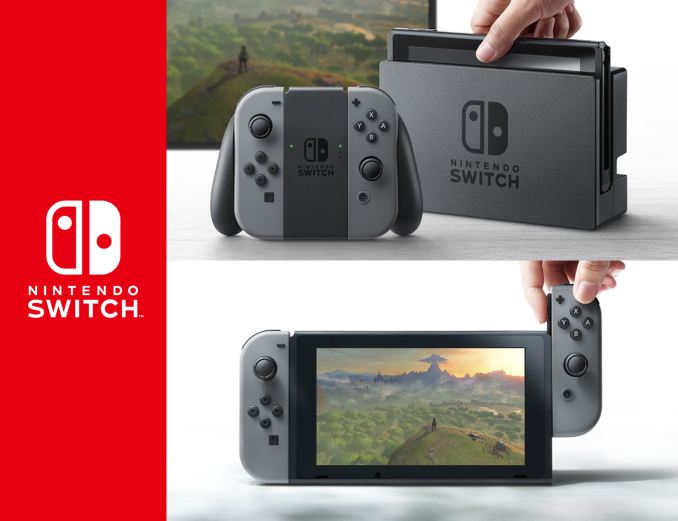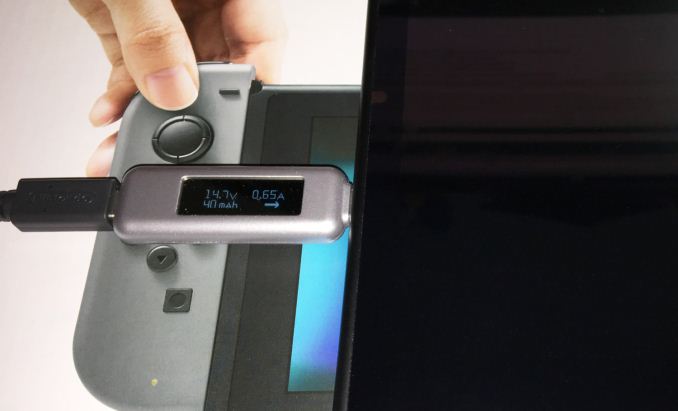Playing With Power: A Look At Nintendo Switch Power Consumption
by Ryan Smith on March 6, 2017 12:00 PM EST
Last week was of course the launch of Nintendo’s eagerly anticipated Switch console. The company’s latest handheld console, the Switch is a bit of an odd duck in pretty much every way. It departs from Nintendo’s traditional and well-established clamshell design in favor of a larger tablet, and under the hood Nintendo has stepped away from their typical highly-custom low-power SoC in favor of a rather powerful Tegra design from NVIDIA. Given that the 3DS was essentially an ARMv6 + OpenGL ES 1.x device, I can’t overstate just how significant of a jump this is under the hood in going to the ARMv8 + OpenGL ES 3.2/Vulkan class Tegra SoC. Nintendo has essentially jumped forward 10 years in mobile technology in a single generation.
| Handheld Game Console Specification Comparison | ||||||
| Nintendo Switch | New Nintendo 3DS XL | Sony PlayStation Vita Slim | ||||
| SoC | CPU | 4x ARM Cortex-A57 | 4x ARM11 | 4x ARM Cortex-A9 | ||
| GPU | NVIDIA Maxwell (256 Cores) |
DMP PICA200 | IMG PowerVR SGX 543MP4 | |||
| Display | 6.2-inch 1280x720p LCD (HDMI: 1080p60) |
Top: 4.9-inch 800x240 Bottom: 4.2-inch 320x240 |
5-inch 960x544 IPS LCD |
|||
| Size | 102 x 239 x 13.9 mm, 297g (tablet only) 398g w/Joy-Cons |
160 x 93.5 x 21.5 mm, 329g | 85.1 x 183.6 x 15 mm, 219g | |||
| Battery | 4310mAh (16Whr) 2.5 to 6.5 Hours |
1750mAh (6.5Whr) 3.5 to 7 Hours |
2210mAh (8.2Whr) 4 to 6 Hours |
|||
| Storage | 32GB NAND + microSDXC | 1GB NAND + microSDHC | 1GB NAND or Proprietary Card | |||
| Wireless | 2.4/5GHz 2x2 802.11ac Bluetooth 4.1 |
802.11g | 2.4GHz 802.11n Bluetooth 2.1 |
|||
| I/O | Console | USB Type-C | Proprietary (USB Compatible) | Micro-USB | ||
| Dock | 1x USB 3.0 2x USB 2.0 1x HDMI 1.x 1x USB-C (power only) |
|||||
| Launch Date | 03/03/2017 | 10/14/2014 | 10/10/2013 | |||
| Launch Price | $299 | $199 | $199 | |||
In any case, in between benchmark runs for other projects over the weekend, I’ve been poking and prodding at the Switch to see if there was anything interesting to find. Nintendo still hasn’t disclosed low-level specifications – nor was I expecting them to – so Digital Foundry’s unofficial analysis remains the best we’re going to see for now. And for a look at the physical layer, iFixit has once again done another one of their wonderful teardowns with the Switch, identifying many of its supporting chips and confirming that the “HD Rumble” motor is indeed a linear actuator, though oddly enough one that works on its short axis instead of its long axis.
Meanwhile thanks to some proxy shenanigans, I’ve been able to get the Switch to run some of our JavaScript benchmarks. The console ships with an integrated, stripped-down version of WebKit for use with various web services, though there’s no proper web browser exposed to the user. However this stripped-down browser clearly isn’t meant for full-on web browsing; with a Kraken 1.1 run time of 172-thousand milliseconds (~2% the throughput of a Tegra-based Pixel C), I suspect the browser isn’t even doing native JS compilation and instead is doing interpretation. So at least for the moment, there’s not much in the way of meaningful benchmarking that can be done.
Nintendo Switch: Playing With Power
However one area that I have had some success with is power measurement. And this is another area where the Switch is a bit of an odd duck, leading to some confusion around the Web judging from some of the comment posts I’ve seen elsewhere. USB Type-C has been shipping in devices for a couple of years now, so it’s hardly a new standard, but given the slow upgrade cycle of PCs and smartphones it still isn’t an interface that the majority of consumers out there have dealt with. Furthermore due to its use case as a game console, the Switch is unlike any other USB Type-C device out there (more on this in a second). So I opted to spend some time profiling the device’s power consumption, in order to shed some light on what to expect.
First off then, what makes the Switch such an odd duck here? This is merely anecdotal, but one of the big hang-ups I’m seeing is that a lot of people aren’t accustomed to using what’s essentially a high-power tablet that’s running at fill-tilt at all times. The secret to the long battery life (and clockspeed turboing) of the iPad and other tablets relative to their size is that they spend the vast majority of their time idling. It doesn’t take a lot of energy at the SoC level to display text or watch a video; the SoC is only called on in short bursts to render something before it goes back to sleep. The Switch, on the other hand, spends the vast majority of its time gaming, meaning the SoC is frequently in its highest power state.
The fact that the Switch lives most of its life at two extremes – asleep or running at full speed – means that it’s a bit unintuitive what to expect from it when it comes to power consumption. Or, for that matter, what to expect when charging it. So, in what’s ultimately an excuse for me to play with a new toy, Satechi’s USB Type-C power meter, I’ve been profiling the power consumption between the Switch and its AC adapter. As a bit of a heads up, the Satechi meter isn’t perfect – the device has to draw a bit of power itself – so if I wanted to be more rigorous about this I’d need to do a proper multimeter setup. But for some quick testing, Satechi’s meter works well enough, especially given the fact that its own power consumption is a drop in the bucket compared to the Switch’s.
Finally, looking at the specifications of the Switch, there are two numbers I want to point out. The first is the power rating of the console’s AC adapter: 15V @ 2.6A, or 39 Watts. This power adapter is quite powerful, more powerful in fact than the 29W adapter Apple includes with the modern 12-inch MacBook. Meanwhile the second number I want to point out is stamped into the bottom of the dock, and that’s the output power rating of the USB-C male port built into said dock for the Switch to connect to. It’s only rated for 15V @ 1.2A, for a total of 18W.
The difference between the two is due to the fact that the Switch dock itself plays host to 3 USB Type-A ports, including a USB 3.0 port on the rear. As a result the power adapter for the Switch apparently needed to be quite a bit oversized to ensure that it never faces a load larger than it can handle. Besides running the Switch, it also potentially needs to be able to power a USB hard drive and charge a couple of Pro Controllers, all of which can add up quickly. Consequently it’s the Dock’s output rating of 18W that’s the more meaningful number as far as Nintendo’s own specifications go.

The Switch's Dock (Image Courtesy iFixit)
Anyhow, that’s enough rambling on background information. Let’s look at the power numbers.











61 Comments
View All Comments
yhselp - Wednesday, March 8, 2017 - link
If Switch draws 8.9W how can it last 2.5 hrs on a 16Whr battery?zodiacsoulmate - Wednesday, March 8, 2017 - link
Good question hahayhselp - Thursday, March 9, 2017 - link
An honest one, too. I don't doubt the validity of Ryan's report, nor those that have tested and confirmed Switch running Zelda at max brightness for over 2.5 hrs. There's something I don't understand. Here's hoping we get an answer.Ryan Smith - Saturday, March 11, 2017 - link
Power conversion inefficiency, for a start. That 15V has to be converted internally to a number of other voltages. The actual intensity of the workload will also vary a bit; I grabbed an early area with a lot of transparency specifically because that tends to be especially hard on the GPU side of things.yhselp - Monday, March 13, 2017 - link
Thanks for replying. Hoping Nintendo releases Switch XL with a FinFET SoC, bigger screen, and much better battery life.Vash63 - Friday, March 10, 2017 - link
Is there a measure of how much power this draws while in sleep mode when NOT charging? Would be useful to see if there's any long term power draw in sleep mode.Ryan Smith - Saturday, March 11, 2017 - link
It's so low that I'd need a multimeter to measure it correctly. The power draw of the USB-C power meter becomes the dominant load.If there is any power draw, I'd say it's low enough to be inconsequential. The Switch does slowly draw down the battery over time, but baring wake-up events (e.g. firing up the WiFi radio) we're talking about a process that would take weeks.
IanAugust - Saturday, March 11, 2017 - link
One question. Is it common for power banks to cause damage to your devices battery. I purchased a imuto taurus x4 20000mAh power bank. I've contacted their support to see if it was possible that the power bank could power the switch while I was playing it (or at the very least) slow the battery drain a bit.But I got some unclear information saying that using the device while the power bank is charging it would cause damage to the battery (not clear which battery they were implying). Is this common or normal to not be allowed to use a device while it's being charge by the power bank?
Thanks!
azazel1024 - Monday, March 13, 2017 - link
One thing to throw out, speaking of battery pack charging ability, go shorter and higher gauge cables if you can manage it. Obviously a 4" cable probably isn't practical for charging the switch, but if you can manage with a 1ft cable over a 3ft, let alone a 6ft cable, go shorter.2 Amps is a fair amount of current to pull on a tiny conductors. A lot of cables only have 28ga data wires and 26ga power wires for USB 2 cables. A few premium wires are 28/26. On a 6ft wire at 2 amps you've got nearly 20% loss due to voltage drop/heat dissipation.
Going up to that premium 24ga power wires and you are talking only a 12.6% drop. Still substantial, but a lot better than wasting 1 in 5 watts.
Go to a 3ft, or even better a 1ft wire and you could be down to a ~2% loss on a short, thick wire.
That is the biggest reason you almost never see 5v charging higher than 2 amps. You end up getting the wires rather warm once you start pushing that much amperage through them.
By comparison, for residential 120/240v wiring you generally want to look at increasing voltage or wire gauge if your calculations come in above a 2% voltage drop...and here we are in USB town tolerating a 20+% drop.
extide - Sunday, May 7, 2017 - link
..and that's why the new higher voltage modes were introduced.